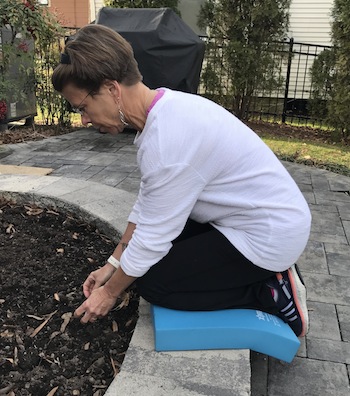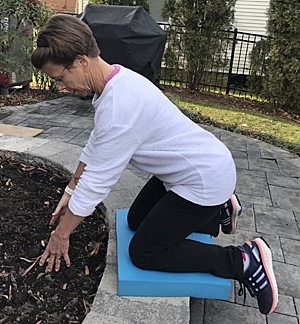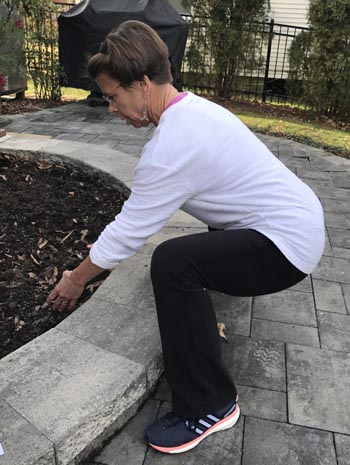Gardening for Aging Children
by Marsha Goldberg, Fairfax Master Gardener
It’s a fickle twist of fate that as we find ourselves with more time to garden, our bodies seem less able to withstand the stress from lifting, pushing, bending and all the other assorted tasks that go with this otherwise gratifying hobby. In fact, when done correctly, the physical work associated with gardening can actually have beneficial effects. You have probably heard the current research that shows that being outside and in the garden can have positive effects on mental health; now, data is showing that as exercise, gardening is almost as beneficial as jogging.
Here are some strategies and moves you can use to help your body benefit from the workout you get when gardening. As much as you love being outside, don’t be too eager to get out as quickly as possible. Your muscles tighten up when you are at rest and circulation decreases, which is why experts now say that you should get up and move at least every 20 minutes. Think about what happens when you sleep! No wonder we often wake up stiff and have to move a bit slowly. Your muscles need time to warm up, which happens as the circulation slowly increases, so give yourself time to let that occur. You can do some gentle yoga stretches in the morning, spend a few leisurely minutes on a treadmill or stationary bike, take a short walk or start the day with a hot shower. All of those activities will loosen up your muscles a bit, especially along your spine. Then start your garden time with less strenuous tasks such as light pruning until your muscles become more flexible.

Not this
Once you are outside and working – you have probably heard this many times -– be sure you lift heavy items by bending your knees and squatting slightly, then pushing off from your quads rather than using your back. Frankie Park-Stryk, a trainer at Arlington Personal Fitness (APF), also recommends that you change your position or task about every 20 minutes.
If you are kneeling to pull weeds, switch to a task you do while standing, such as raking leaves or weeding with a hoe. And, if you are bending over and stretching your back forward, stand up, raise your arms overhead and stretch backwards slightly. You can do it with a wall behind you if you are worried about balance, but I find it helpful to grab onto the handle of a light tool and lift it overhead to give me some stability.

This
Second, be sure to switch sides when you are engaged in a task, Park-Stryk says. If you normally pull a rake across your body from right to left, try reversing hands and pull the rake in the opposite direction. It will be a bit awkward at first but it will give both sides of your body an equal workout. When planting seeds or pulling weeds, try squatting –- feet apart, toes pointed slightly out and knees aligned over your toes –- instead of bending over from your waist.
This will strengthen both your hamstrings and your quads; strong thigh muscles will provide better support to your knees at all times. As an alternative, Park-Stryk says, try using a lunge position to do ground work. From a standing position, put one leg behind you, bend the knee of your forward leg, and let the bend come from your hips as you press down into the lunge. Don’t forget to change legs periodically. Again, this is a great strengthening and stretching move.

A good squat
If you prefer kneeling on the ground, be sure to use a pad to protect your knees and avoid kneeling all the way back with your glutes on your heels, which compresses the knees. Instead, keep your knees at a 90-degree angle and bend forward from your hips.
Stephanie Mendes, also a trainer at APF, adds that you should take time to stretch your muscles when you are finished gardening. When you use your muscles for stability, such as when you are squatting, or when you are engaged in strength building tasks such as raking, pushing a wheelbarrow or forking over compost, the muscles become constricted and tight. Simple stretches afterwards will prevent a lot of pain the next day. Ease tension in your wrists by leaning on the back of your hands so that they are at a 90-degree angle to your arms; then reverse your hands and lean on the palms.

A lunge, a comfortable working position
To learn which stretch to use for what ails you, take a look at 36 Pictures to See Which Muscles You’re Stretching.
If you have had chronic health problems or a chronic condition such as arthritis, be sure you consult with your doctor or health care provider before you engage in strenuous exercise or stretching. But whatever your stage in life or your gardening skills, a bit of planning and the right moves will keep you happily occupied for years to come!
…updated 2021